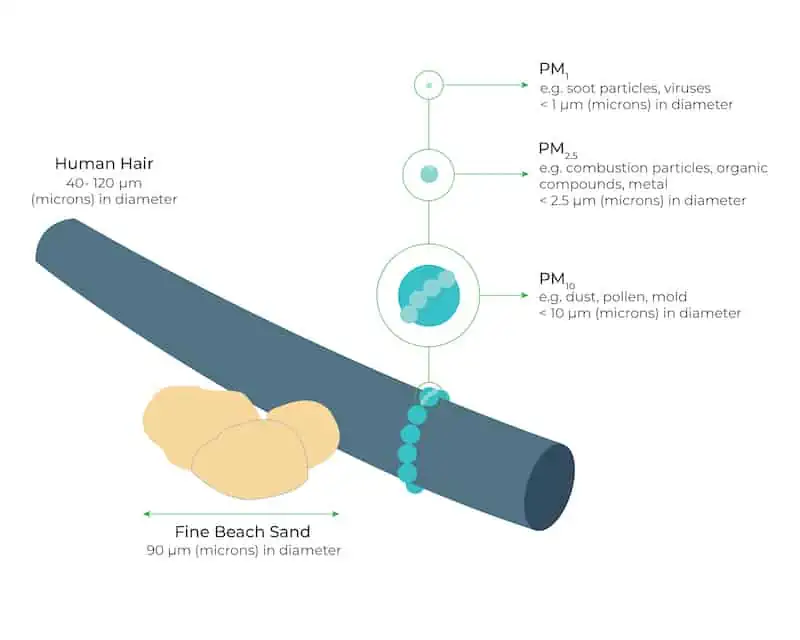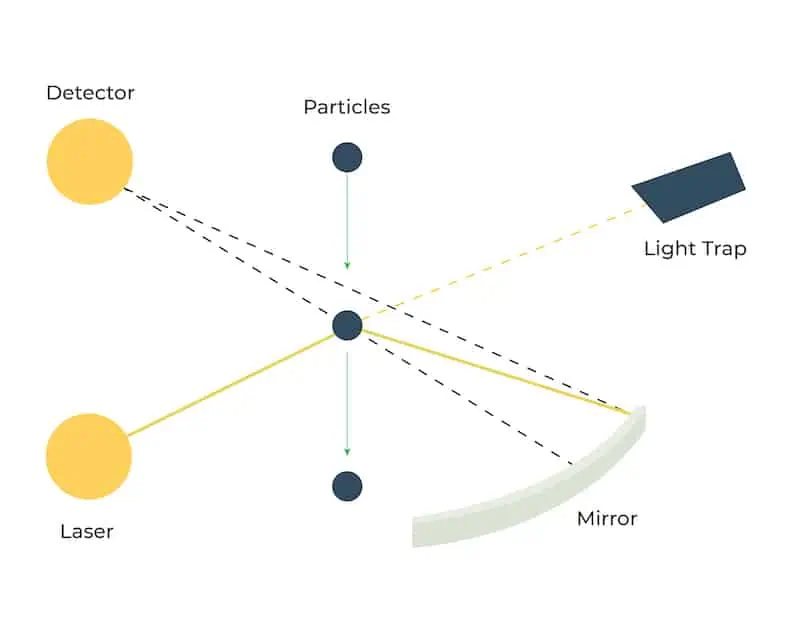What is PM2.5?
“PM”, Particulate Matter, is not a single pollutant, but refers to a complex mixture of solids and aerosols of varying shape, size, and chemical composition and may contain many chemical species like organic compounds, inorganic ions, metallic compounds, elementary carbon, etc. So, these atmospheric particles are defined by their diameter for air quality regulatory purposes.

The fine inhalable particles that are less than or equal to 2.5 micrometers in diameter are collectively known as PM2.5. They are more than 100 times thinner than a human hair (too small to be detectable by the human eye) making them more harmful than larger particles as they can penetrate deeper into the human respiratory tract when inhaled.
PM2.5 in the atmosphere consists of toxic organic compounds and also heavy metals released from various sources. Once released, they stay in the air for a long time i.e. days or weeks and can travel hundreds of miles.
Sources
Emission of particulate matter PM2.5 is either directly from a source (primary PM) or through the chemical reactions of gases such as oxides of sulfur (SOx), nitrogen oxides (NOx), organic compounds, etc. in the atmosphere (secondary PM). Simultaneously, the natural sources of particulate matter are wind-blown dust from open land, pollen, spores, mold, dirt, soil erosion, and forest fires. Whereas, anthropogenic sources of PM2.5 include:
- Burning fossil fuels such as gasoline, oil, diesel or wood, etc.
- Waste burning, agricultural burning, etc.
- Also emission from motor vehicle exhaust
- Emission from energy supply and also from industrial combustion processes
- Metal and steel production, specifically smelting and processing of metals
Permissible levels of PM2.5
The breakpoint concentrations describing the quality of air based on the PM2.5 concentrations for different countries are given below. In India, the daily average PM2.5 levels of up to 60 μg/m3 are satisfactory. The Air quality guidelines by the World Health Organization suggest a 24-hr mean of 25 μg/m3.
Breakpoints of PM2.5 (μg/m3)
| India (24-hr) | US (24-hr) | China (24-hr) | EU (8-hr) | ||||
| AQI Category | Breakpoint concentration | AQI Category | Breakpoint concentration | AQI Category | Breakpoint concentration | AQI Category | Breakpoint concentration |
| Good | 30 | Good | 35 | Excellent | 15 | Very low | 10 |
| Satisfactory | 60 | Moderate | 75 | Good | 35 | Low | 20 |
| Moderately polluted | 90 | Unhealthy for sensitive | 115 | Lightly Polluted | 65 | Medium | 30 |
| Poor | 150 | Unhealthy | 150 | Moderately Polluted | 150 | High | 60 |
| Very Poor | 250 | Very Unhealthy | 250 | Heavily Polluted | 250 | Very high | 60+ |
| Severe | 250+ | Hazardous | 250+ | Severely Polluted | 250+ |
Health & Environmental Impact of PM2.5
Health Impact
The potential of particulate matter to affect human health depends directly on the size of particulate matter. The particles with < 10μm diameter generally pass through the nose and throat and enter the lung. PM2.5 particles are so small that they tend to travel deep into the lungs through the respiratory tract and deposit on the surface of the deeper parts of the lung inducing tissue damage, and lung inflammation.
PM2.5 (i.e. up to 24-hours) causes irritation to the eyes, nose, throat, and upper respiratory tracts, coughing, sneezing, and shortness of breath when inhaled for short periods. It aggravates already present respiratory diseases such as asthma and can result in premature mortality, acute and chronic bronchitis, other respiratory symptoms, etc.
Exposure to PM2.5 pollution, for a long period (i.e. months or years), can cause permanent respiratory problems such as asthma, chronic bronchitis, and heart disease and cause reduced lung function growth in children. It can also lead to premature death, particularly for people suffering from chronic lung or heart diseases. Whereas, children are the most vulnerable. Increases in particulate matter levels, specifically PM2.5 have been linked to an increase in deaths due to viruses such as novel coronavirus disease (COVID-19). Harvard University, in one of its studies, has claimed that an increase in the PM2.5 values by 1 µg/m3, corresponded to an 8% increase in the COVID-19 deaths.
Environmental impact
The major environmental impacts of PM2.5 pollution are visibility reduction and smog. Particulate matter, specifically PM2.5 alters the absorption and scattering of light in the atmosphere affecting visibility. Additionally, the settling of the air-borne particles on plants, soil, and water ecosystems has harmful effects on them. The metal and organic compounds reduce plant growth and yield while the deposition of PM into water bodies affects its quality and clarity.
Atmospheric particles affect the heating and cooling of the atmosphere, some components of PM such as black carbon promote climate warming while some components such as sulfates and nitrates have cooling properties. PM2.5 particles are also the major precursors of smog.
Possible corrective measures
The primary step in PM2.5 monitoring is to identify the areas with high particulate levels or areas where air quality does not meet the PM2.5 national standards. In addition to this, the following corrective measures can be taken:
- Limit outdoor activities and close windows and vents during times of high air pollution.
- Avoid keeping your vehicle idle for so long.
- Avoid areas with traffic congestions, construction activities, or unpaved roads, breathing such polluted air daily also leads to health effects in the long run.
- Also eliminate the use of the fireplace, wood stove, gas-powered lawn, or garden equipment.
- Also, eliminate open burning of leaves, trash, or other materials
How to Measure 2.5 Levels
Different working principles for particulate matter monitoring in the ambient environment are Gravimetric, TOEM, Beta Attenuation (BAM), and also Laser scattering.
High-volume Gravimetric Method
The PM2.5 monitors based on the gravimetric principle takes in the ambient air for 24 hours at a constant flow rate through a size-selective inlet that only allows particulate matter with an aerodynamic diameter of 2.5µm or less to pass through. The particulate matter is collected onto a pre-weighed filter conditioned at constant temperature and humidity conditions. Also, after the 24-hour sampling period, the filter is conditioned again under the same temperature-humidity conditions and reweighted. Therefore, the difference in the weight corresponds to the mass collected on the filter, which along with known flow rate, sampling period, and the total volume of the air sampled is used to calculate the PM2.5 concentration.
Tapered Element Oscillating Microbalance (TOEM)
It is a proprietary system for particulate matter monitoring. Subsequently, the PM2.5 monitor based on TOEM determines the PM2.5 concentration by continuously weighing the particulates deposited on the filter attached to a hollow tapered element that oscillates in an applied electric field. Also, the oscillating frequency decreases with the accumulation of particulates on the filters. As a result, thermal mass flow controllers constantly control and measure the flow rate of the PM2.5 monitor which along with the mass concentration, temperature, and other factors is used to continuously calculate the PM2.5 concentrations.
Beta Attenuation Monitor (BAM)
The PM2.5 monitoring is based on the BAM principle which measures the particle mass density using beta radiation attenuation, the particulates in the ambient air drawn into the PM2.5 monitor are deposited on a paper-band filter and exposed to beta rays (i.e. electrons with energies in the 0.01 to 0.1 MeV range) which get attenuated as a function of the particulate mass. As a result, the beta count reduces with an increase in the PM2.5 mass and is recorded by the detector and converted to concentration.
Laser Scattering
The PM2.5 monitor based on the physical principle of light scattering, also known as optical particle counter (OPC), measures dust particles illuminated by laser light at a 90° angle. Whereas, the light scattered from each particle is collected at approximately 90° by a mirror and detected by a photo-diode. This signal is then fed into a multi-channel size classifier where a pulse height analyzer is used to classify each pulse that is proportional to the particle size. As a result, the counts in the channel corresponding to PM2.5 convert to the concentration of PM2.5.

Among all the above principles of PM2.5 monitoring, PM monitors based on laser scattering are typically found to be preferred for ambient air monitoring because they yield quick and accurate measurements and are inexpensive in comparison with the others.
Oizom’s working principle for PM2.5 monitoring
Oizom’s DUSTROID is an online particulate monitoring system that measures the concentration of various particulate sizes ranging from 1 micron to 100 microns such as PM1, PM2.5, PM10, and PM100 in the ambient air. Our PM sensor works on the principle of laser scattering hence, the active sampling-powered sensor-based air quality monitor DUSTROID is deployed across several cities, campuses, universities. They are also used for drawing actionable insights to tackle the rise in ambient PM2.5 concentrations. Also, refer to case studies on air pollution for more information.
5 reasons why PM2.5 monitoring is important:
- PM2.5 is a complex mixture of solid and aerosols of very small size (about 100 times thinner than human hair) that can easily pass through the nose and throat and penetrate deep into the lungs and cause severe health issues.
- Particulate matter is emitted into the atmosphere from vehicular exhaust, power plants, combustion processes such as burning fossil fuels, waste, etc. They are also formed into the atmosphere from various chemical reactions of other air pollutants such as NOx and SOx.
- When inhaled, it irritates the eyes, nose, throat, and airways and can also lead to aggravation of respiratory diseases leading to premature mortality, acute and chronic bronchitis, other respiratory symptoms, etc.
- PM2.5 monitoring is an efficient way to detect high concentrations of particulate matter and also prevent high-level exposures.
- Real-time monitoring of particulate matter PM2.5 levels helps in calculating the air quality index to deliver health advisories as well as formulating an action plan to meet standards.


